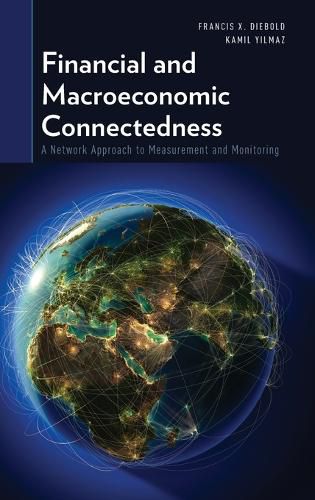Financial and Macroeconomic Connectedness: A Network Approach to Measurement and Monitoring
Francis X. Diebold (Professor of Economics, Professor of Economics, University of Pennsylvania),Kamil Yilmaz (Professor of Economics, Professor of Economics, Kog University)

Financial and Macroeconomic Connectedness: A Network Approach to Measurement and Monitoring
Francis X. Diebold (Professor of Economics, Professor of Economics, University of Pennsylvania),Kamil Yilmaz (Professor of Economics, Professor of Economics, Kog University)
Connections among different assets, asset classes, portfolios, and the stocks of individual institutions are critical in examining financial markets. Interest in financial markets implies interest in underlying macroeconomic fundamentals. In Financial and Macroeconomic Connectedness, Frank Diebold and Kamil Yilmaz propose a simple framework for defining, measuring, and monitoring connectedness, which is central to finance and macroeconomics. These measures of connectedness are theoretically rigorous yet empirically relevant. The approach to connectedness proposed by the authors is intimately related to the familiar econometric notion of variance decomposition. The full set of variance decompositions from vector auto-regressions produces the core of the ‘connectedness table.’ The connectedness table makes clear how one can begin with the most disaggregated pair-wise directional connectedness measures and aggregate them in various ways to obtain total connectedness measures. The authors also show that variance decompositions define weighted, directed networks, so that these proposed connectedness measures are intimately related to key measures of connectedness used in the network literature.After describing their methods in the first part of the book, the authors proceed to characterize daily return and volatility connectedness across major asset (stock, bond, foreign exchange and commodity) markets as well as the financial institutions within the U.S. and across countries since late 1990s. These specific measures of volatility connectedness show that stock markets played a critical role in spreading the volatility shocks from the U.S. to other countries. Furthermore, while the return connectedness across stock markets increased gradually over time the volatility connectedness measures were subject to significant jumps during major crisis events. This book examines not only financial connectedness, but also real fundamental connectedness. In particular, the authors show that global business cycle connectedness is economically significant and time-varying, that the U.S. has disproportionately high connectedness to others, and that pairwise country connectedness is inversely related to bilateral trade surpluses.
This item is not currently in-stock. It can be ordered online and is expected to ship in approx 2 weeks
Our stock data is updated periodically, and availability may change throughout the day for in-demand items. Please call the relevant shop for the most current stock information. Prices are subject to change without notice.
Sign in or become a Readings Member to add this title to a wishlist.

